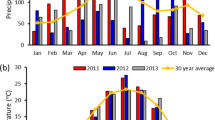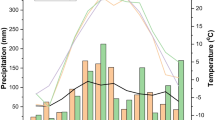Abstract
High yielding, native warm-season grasses could be used as renewable bioenergy feedstocks. The objectives of this study were to determine the effect of warm season grass monocultures and mixtures on yield and chemical characteristics of harvested biomass and to evaluate the effect of initial seeding mixture on botanical composition over time. Switchgrass (Panicum virgatum L.), indiangrass [Sorghastrum nutans (L.) Nash], and big bluestem (Andropogon gerardii Vitman) were planted as monocultures and in all possible two- and three-way mixtures at three USA locations (Brookings and Pierre, SD and Morris, MN) during May 2002. Biomass at each location was harvested after a killing frost once annually from 2003 to 2005. Total biomass yield significantly increased with year at all locations. Switchgrass monocultures or mixtures containing switchgrass generally out-yielded big bluestem or indiangrass in monocultures or the binary mixture. Cellulose and hemicellulose concentrations were higher in 2004 and 2005 compared with 2003. Switchgrass or mixtures containing switchgrass tended to have less cellulose than either big bluestem or indiangrass. Results were more variable for total N, lignin, and ash. Switchgrass was the dominant component of all mixtures in which it was present while big bluestem was dominant when mixed with indiangrass. Indiangrass was maintained only in monocultures and declined over years when grown in mixtures at all locations. Our results indicated if biomass yield in the northern Great Plains is a primary objective, switchgrass should be a component of binary or tertiary mixtures that also contain big bluestem and/or indiangrass.







Similar content being viewed by others
Abbreviations
- N:
-
Nitrogen
- NDF:
-
Neutral detergent fiber
- ADF:
-
Acid detergent fiber
- ADL:
-
Acid detergent lignin
- TN:
-
Total nitrogen
References
Casler MD, Boe AR (2003) Cultivar × environment interactions in switchgrass. Crop Sci 43:2226–2233
McLaughlin SB, DeLaTorreUgarte DG, Garten CT, Lynd LR, Sanderson MA, Tolbert VR et al (2002) High-value renewable energy from prairie grasses. Environ Sci Technol 36:2122–2129
McLaughlin SB, Walsh ME (1998) Evaluating environmental consequences of producing herbaceous crops for bioenergy. Biomass Bioenergy 14:317–324
Muir JP, Sanderson MA, Ocumpaugh WR, Jones RM, Reed RL (2001) Biomass production of ‘Alamo’ switchgrass in response to nitrogen, phosphorus, and row spacing. Agron J 93:896–901
Sanderson MA, Read JC, Reed RL (1999) Harvest management of switchgrass for biomass feedstock and forage production. Agron J 91:5–10
Vogel KP, Brejda JJ, Walters DT, Buxton DR (2002) Switchgrass biomass production in the Midwest USA: harvest and nitrogen management. Agron J 94:413–420
Griffith AP, Epplin FM, Fuhlendorf SD, Gillen R (2011) A comparison of perennial polycultures and monocultures for producing biomass for biorefinery feedstock. Agron J 103:617–627
Heggenstaller AH, Moore KJ, Liebman M, Anex RP (2009) Nitrogen influences biomass and nutrient partitioning by perennial, warm-season grasses. Agron J 101:1363–1371
Waramit N, Moore KJ, Heggenstaller AH (2011) Composition of native warm-season grasses for bioenergy production in response to nitrogen fertilization rate and harvest date. Agron J 103:655–662
Moore KJ, Boote KJ, Sanderson MA et al (2004) Physiology and developmental morphology. In: Moser LE (ed) Warm-season (C4) grasses. Agronomy Monograph No. 45. ASA, CSSA, and SSSA, Madison, pp 179–216
Lee DK, Owens VN, Doolittle JJ (2007) Switchgrass and soil carbon sequestration response to ammonium nitrate, manure, and harvest frequency on conservation reserve program land. Agron J 99:462–468
McLaughlin SB, Samson R, Bransby D, Wiselogel A (1996) Evaluating physical, chemical, and energetic properties of perennial grasses as biofuels. In: Abstracts of BioEnergy ’96—The Seventh National Bioenergy Conference: Partnerships to Develop and Apply Biomass Technologies, Nashville, TN. September 15–20
Garten CT, Wullschleger SD (2000) Soil carbon dynamics beneath switchgrass as indicated by stable isotope analysis. J Environ Qual 29:645–653
Liebig MA, Schmer MR, Vogel KP, Mitchell RB (2008) Soil carbon storage by switchgrass grown for bioenergy. Bioenerg Res 1:215–222
Mulkey VR, Owens VN, Lee DK (2006) Management of switchgrass-dominated conservation reserve program lands for biomass production in South Dakota. Crop Sci 46:712–720
Hector A, Schmid B, Beierkuhnlein C, Caldeira MC, Deimer M, Dimitrakopoulos PG et al (1999) Plant diversity and productivity experiments in European grasslands. Science 286:1123–1127
Tilman D, Reich P, Knops J, Wedin D, Mielke T, Lehman C (2001) Diversity and productivity in a long-term grassland experiment. Science 294:843–845
Tilman D (1996) Biodiversity: population versus ecosystem stability. Ecology 77:350–363
Grime JP (1997) Biodiversity and ecosystem function: the debate deepens. Science 277:1260–1261
Huston MA (1997) Hidden treatments in ecological experiments: reevaluating the ecosystem function of biodiversity. Oecologia 110:449–460
Tilman D, Hill J, Lehman C (2006) Carbon-negative biofuels from low-input high-diversity grassland biomass. Science 314:1598–1600
DeHaan LR, Weisberg S, Tilman D, Fornara D (2010) Agricultural and biofuel implications of a species diversity experiment with native perennial grassland plants. Agric Ecosyst Environ 137:33–38
Schmer MR, Vogel KP, Mitchell RB, Perrin RK (2008) Net energy of cellulosic ethanol from switchgrass. Proc Natl Acad Sci U S A 105:464–469
Mulkey VR, Owens VN, Lee DK (2008) Management of warm-season grass mixtures for biomass production in South Dakota USA. Bioresour Technol 99:609–617
Garcia-Ciudad A, Garcia-Criado B, Perez-Corona ME, Vazquez de Aldana BR, Ruano-Ramos AM (1993) Application of near-infrared reflectance spectroscopy to chemical analysis of heterogeneous and botanically complex grassland samples. J Sci Food Agric 63:419–426
Undersander D, Mertens DD, Thiex N (1993) Total ash in forages. Forage Analysis Procedures. National Forage Testing Association, Omaha
SAS Institute (1996) SAS system for mixed models. SAS Inst, Cary
Gomez KA, Gomez AA (eds) (1984) Statistical procedures for agricultural research. Wiley, New York
Fuentes RG, Taliaferro CM (2002) Biomass yield stability of switchgrass cultivars. In: Janick J, Whipkey A (eds) Trends in new crops and uses. ASHS, Alexandria
Briggs JM, Knapp AK (1995) Interannual variability in primary production in tallgrass prairie: climate, soil moisture, topographic position, and fire as determinants of aboveground biomass. Am J Bot 82:1024–1030
Shiflet TN, Dietz HE (1973) Relationship between precipitation and annual rangeland herbage production in Southeastern Kansas. J Range Manage 27:272–276
Smart AJ, Dunn BH, Johnson PS, Xu L, Gates RN (2007) Using weather data to explain herbage yield on three great plains plant communities. Rangel Ecol Manag 60:146–153
Lee DK, Boe A (2005) Biomass production of switchgrass in central South Dakota. Crop Sci 45:2583–2590
Picasso VD, Brummer EC, Liebman M, Dixon PM, Wilsey BJ (2011) Diverse perennial crop mixtures sustain higher productivity over time based on ecological complementarity. J Renew Agric Food Syst 26:317–327
Picasso VD, Brummer EC, Liebman M, Dixon PM, Wilsey BJ (2008) Crop species diversity affects productivity and weed suppression in perennial polycultures under two management strategies. Crop Sci 48:331–342
Weaver JE (1954) The North American Prairie. Johnsen, Lincoln
Springer TL, Aiken GE, McNew RW (2001) Combining ability of binary mixtures of native warm-season grasses and legumes. Crop Sci 41:818–823
Author information
Authors and Affiliations
Corresponding author
Rights and permissions
About this article
Cite this article
Hong, C.O., Owens, V.N., Lee, D.K. et al. Switchgrass, Big Bluestem, and Indiangrass Monocultures and Their Two- and Three-Way Mixtures for Bioenergy in the Northern Great Plains. Bioenerg. Res. 6, 229–239 (2013). https://doi.org/10.1007/s12155-012-9252-9
Published:
Issue Date:
DOI: https://doi.org/10.1007/s12155-012-9252-9




